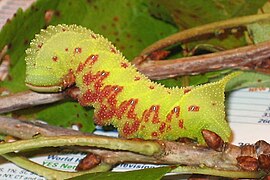Paonias excaecata
| Paonias excaecata | ||||||||||||
|---|---|---|---|---|---|---|---|---|---|---|---|---|

Paonias excaecata |
||||||||||||
| Systematics | ||||||||||||
|
||||||||||||
| Scientific name | ||||||||||||
| Paonias excaecata | ||||||||||||
| ( JE Smith , 1797) |
Paonias excaecatus is a butterfly ( moth ) from the family of moth (Sphingidae).
features
butterfly
The moths have a fore wing length of 24 to 40 millimeters. They can be distinguished from the other species of the genus Paonias mainly by the outer edge of the forewings. In Paonias excaecata this is strongly corrugated over the entire length, whereas in Paonias myops it is fairly uniform with arches near the tip and the anal angle and almost straight in Paonias astylus . On the underside of the forewings, the base is colored pink, which also distinguishes the species from the rest of its genus, but has a commonality with the species of the genus Smerinthus . The moths are variable in both their body size and their color. Individuals from the Prairie Provinces tend to be smaller and much darker in color, while individuals from the southern United States tend to be much larger. The proportion of pink on the underside of the forewing is also variable.
Caterpillar
The caterpillars are occupied from the second stage with numerous setae , which make the body surface appear very coarse. On the sides they have seven rather wide, white, diagonal stripes. In most animals, only the last stripe, which extends to the anal horn , is drawn more vigorously. In many animals, red to reddish brown spots are formed around the spiracles and on the back. This feature can be very variable depending on the individual.
Doll
The pupa is reddish brown and has a more or less rough surface. The abdomen segments are slightly indented in places. The short proboscis is fused with the body. The cremaster is short, triangular and ends in a sharp point.
Occurrence
The species is widespread in North America and occurs even further north than the equally widespread Paonias myops . However, the species is becoming rarer in the southern United States. They can be found in the east of Maine to central Florida. Further to the west, the distribution extends over the Great Plains to the region around the Four Corners in Colorado, Utah, Arizona and New Mexico. To the north, the distribution extends to the Pacific coast of Washington, Oregon and northern California. In eastern Canada, the species has been recorded north to Nachvak Fiord at the northern tip of Labrador and Corner Brook in Newfoundland. Further south, the species is common in the provinces on the Atlantic coast. The distribution includes southern Quebec and large parts of Ontario. In the Canadian Prairie Provinces, it is in the south of Manitoba, north to Prince Albert (Saskatchewan) and at least north to Lac La Biche and Fairview in Alberta. In British Columbia the species is distributed in the south to Vancouver Island .
The animals are widespread in the deciduous forests of the United States and Canada. In the Great Plains, however, it is restricted to watercourses with vegetation of willow and rose plants .
Way of life
There is no evidence that the adults would ingest food. The morphological features also suggest that this does not happen. The moths often appear at artificial light sources, at least in the north of their range.
In Canada and the northern states of the USA, the species usually flies between mid-June to mid-July, sometimes until the beginning of August. It is undoubtedly only one generation. The species flies much longer further south. In Florida and Louisiana, it occurs in presumably several generations from March to October.
Food of the caterpillars
The caterpillars feed on many different types of deciduous trees and shrubs. They have been found in the rose family (Rosaceae), willow family (Salicaceae), birch family (Betulaceae) and elm family (Ulmaceae).
development
The females lay their eggs one by one on the host plants. The caterpillars are loners. Pupation takes place in a chamber in the ground just below the surface.
supporting documents
Individual evidence
- ↑ a b c d e f g h i James P. Tuttle: The Hawkmoths of North America, A Natural History Study of the Sphingidae of the United States and Canada. The Wedge Entomological Research Foundation, Washington, DC 2007, ISBN 978-0-9796633-0-7 , pp. 120f.
literature
- James P. Tuttle: The Hawkmoths of North America, A Natural History Study of the Sphingidae of the United States and Canada. The Wedge Entomological Research Foundation, Washington, DC 2007, ISBN 978-0-9796633-0-7 .




